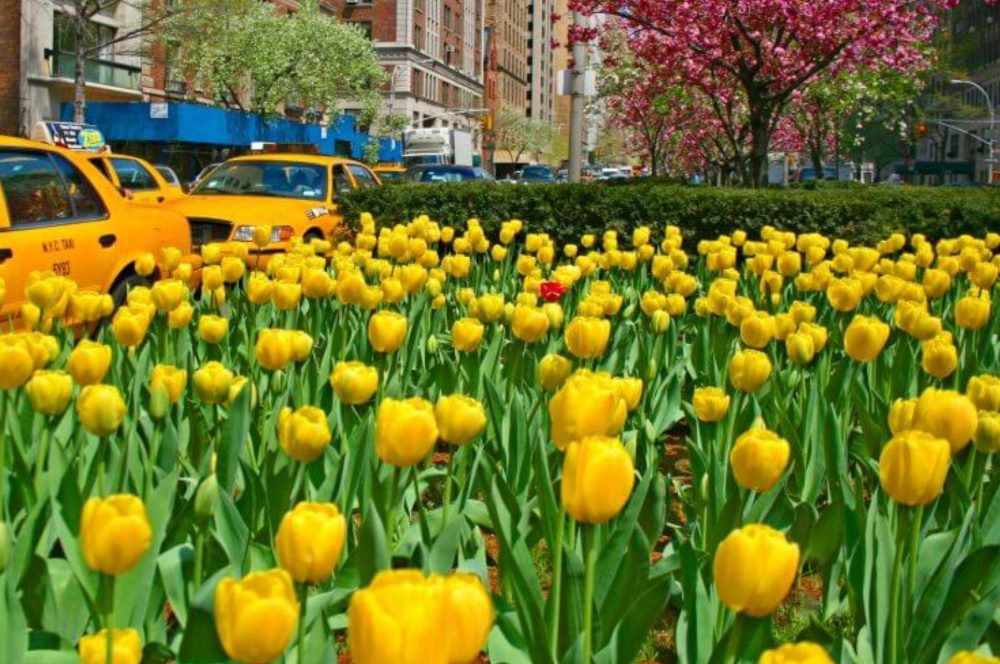The No-Work Way to Plant Tulips
We’ve found an obscure tip for planting tulips this fall. Don’t dig holes at all. That’s a method called “Till and Fill.” Or defy instructions about digging holes that are 6 inches, 7 inches deep. Just dig holes two inches deep.
We hear you saying huh? But the Cornell Flower Bulb Research Program discovered this more than ten years ago, and somehow the news never got out.

Method No. 1: The Annual Tulip Bed
Consider making your tulip bed like the annual beds at Keukenhof in Holland, or on Park Avenue, Clean up a bed in your yard. Then rototill it or use a garden fork to loosen the soil down to a couple of inches.
Lay the tulip bulbs on top of the soil in tight fashion, as if they were in an egg crate, leaving half-an-inch between each bulb. The method is called “top planting.” William B. Miller was a professor of horticulture and director of Cornell’s Flower Bulb Research Program when the news “Researcher offers toil-free tip to plant tulips” was announced in 2011. He proudly called it “a good way to go.” And his lab work proved it.
In this setup, 100 bulbs would fill only a small space, about two-by-six feet. This is for one year only, so no need to fertilize.
Now mulch. Your local government may offer free mulch from shredded trees, twigs and bark. Or try straw, chopped leaf matter, a mixture. Make sure the blanket of mulch is four inches high. Water if the ground is dry. You are done.
This is called the “Till and Fill” method, and it worked. No digging at all. After they bloom, use a rake to dig the tulips and mulch out of the bed.
Just as Keukenhof and Park Avenue, the bulbs are there for one season only. (Keukenhof mulches them; Park Avenue gives them away.) Don’t wait until the leaves die down. Now the bed is ready for tomatoes or dahlias, maybe a mixed summer flowers.

Method No.2 The Perennial Tulip Bed
Bill Miller was back again in 2019 in a Cornell Flower Bed Research Program newsletter to advise you to keep your digging to a minimum to guarantee perennial return. Forget planting tulips 6 or 8 inches deep, he says. “Shallower planting should generally be advised.”
Cornell’s test beds prove that planting as shallow as two inches, covering with soil, and then mulching – even in Cornell’s 5b climate – yields the most abundant return tulip blooms after three years. Here’s how to do it.
Dig a bed two inches deep. In the fall, a rototiller helps to loosen the soil. Otherwise try a garden fork. Spread BulbTone, the 3-5-3 fertilizer, lightly, over the soil. Place your bulbs about four inches apart. Fill in the soil with a shovel. Mulch, perhaps topping with a blanket of shredded leaves or straw. The overall level of mulch should be four inches.
Miller’s studies at Cornell show decisively that tulips planted in deep holes do not come back year after year as well as tulips planted in shallow holes. As long as a gardener mulches deeply over the winter, not just the first year but every year.
What price tulips? There are bulk bags for as little as $42.56 for 100 yellow Rotteveel Darwins on Amazon. Darwins bloom mid-season and have long, sturdy stems. Buy the same type, they bloom at the same time.
Darwins are available from Tulip World for $7 to $10 for 25 bulbs.
Linda Lee
Linda Lee is a former writer and editor at The New York Times.
